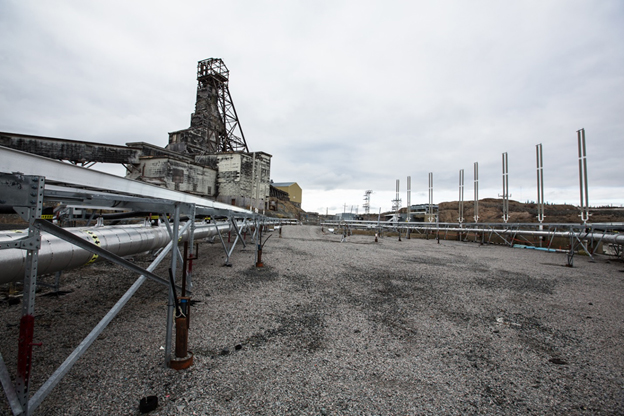The Remediation Project's Frozen Block Method
The frozen block method will safely manage the arsenic trioxide waste at Giant Mine.
About freezing the chambers and stopes
There are 5 stopes and 11 chambers on the site that workers will freeze using the frozen block method. Stopes are large, irregular-shaped spaces left underground when the gold-bearing rock was mined out. The chambers were built to contain the arsenic trioxide dust. Chambers have a more uniform, rectangular shape than stopes. Arsenic trioxide dust was pumped into the 5 stopes and 10 of the chambers. The last chamber will hold arsenic-impacted waste after site remediation, as will the B1 Pit. The chambers, stopes and B1 pit will be frozen into 4 freeze areas. They will not be frozen separately.
Why was the frozen block method chosen?
Safety was the most important factor in choosing the frozen block method to address the arsenic trioxide waste. The safest way to manage the waste is to freeze it where it is, undisturbed, and prevent it from contaminating the underground water.
This involves cooling the surrounding rock to create a frozen block, or a shell. Freezing the arsenic trioxide dust and the surrounding rock will isolate the dust from the environment. Water will not seep in or out of the frozen zones, preventing the release of arsenic.
Freezing the arsenic trioxide in place is the best strategy for managing the arsenic for the long-term to protect people and the environment. Of all the options considered, it offers the fewest risks. Freezing the arsenic has the lowest risk of:
- harming worker and community health and safety
- releasing arsenic into the environment
- releasing arsenic over the long term
Removing the waste would be unsafe for the workers and for the nearby communities. In addition, it is not possible to get all the waste out of the chambers and stopes, meaning this area would require additional levels of management. Removed waste would also need to be stored, creating another contaminated area.
This decision came after 3 years (2001-2003) of extensive scientific and technical research, and community consultation. The Project team considered 56 options for managing the arsenic. 12 were studied in detail. Finally, the frozen block method was chosen based on:
- scientific evidence
- community input
- support from the Independent Peer Review Panel
While the Environmental Assessment concluded the frozen block method was the most appropriate technical solution currently available, it also determined that emerging technologies should continue to be investigated. The Giant Mine Oversight Board is tasked with supporting research into technical approaches that could serve as a permanent solution.
How will the frozen block be created?

Freezing the arsenic trioxide will occur in stages over a number of years. This will ensure the chambers, stopes and surrounding rock are completely frozen, at -5°C or lower.
The Project team will achieve the freezing by using a passive system. This system uses tall, metal tubes called thermosyphons. Thermosyphons draw and expel heat from the ground, using pressurized carbon dioxide. When heated below ground, the carbon dioxide rises as a gas. This gas then cools above ground and becomes a liquid, which – because it is heavier – drops back down underground, warms up, and becomes a gas that rises again. Because of this ongoing cycle, thermosyphons do not need an external source of power to keep the ground frozen.
Thermosyphons are commonly used to keep ground frozen. For example, thermosyphons are used in the parking lot of the Legislative Assembly in Yellowknife. There, they prevent the natural permafrost from thawing. Thermosyphons are also used to maintain frozen core dams at the Ekati Diamond Mine.
When the system is in place, the frozen blocks should stay frozen indefinitely. Even without thermosyphons, once frozen, the solid ice block would take more years to melt. Thermosyphons do not need power. Instead, they use the cold air in winter to cool the ground. As a precaution, thermistors will monitor the ground and air temperatures. If the blocks start to thaw, the project would take actions to refreeze the ground either through an active freeze system or additional thermosyphons.
Climate change was also taken into consideration. The technical advisor's calculations show that the system will work even if the region's average temperatures go up several degrees. Sophisticated equipment will monitor the site on an ongoing basis. The Project team will make adjustments to maintain the frozen areas.
Learn more: